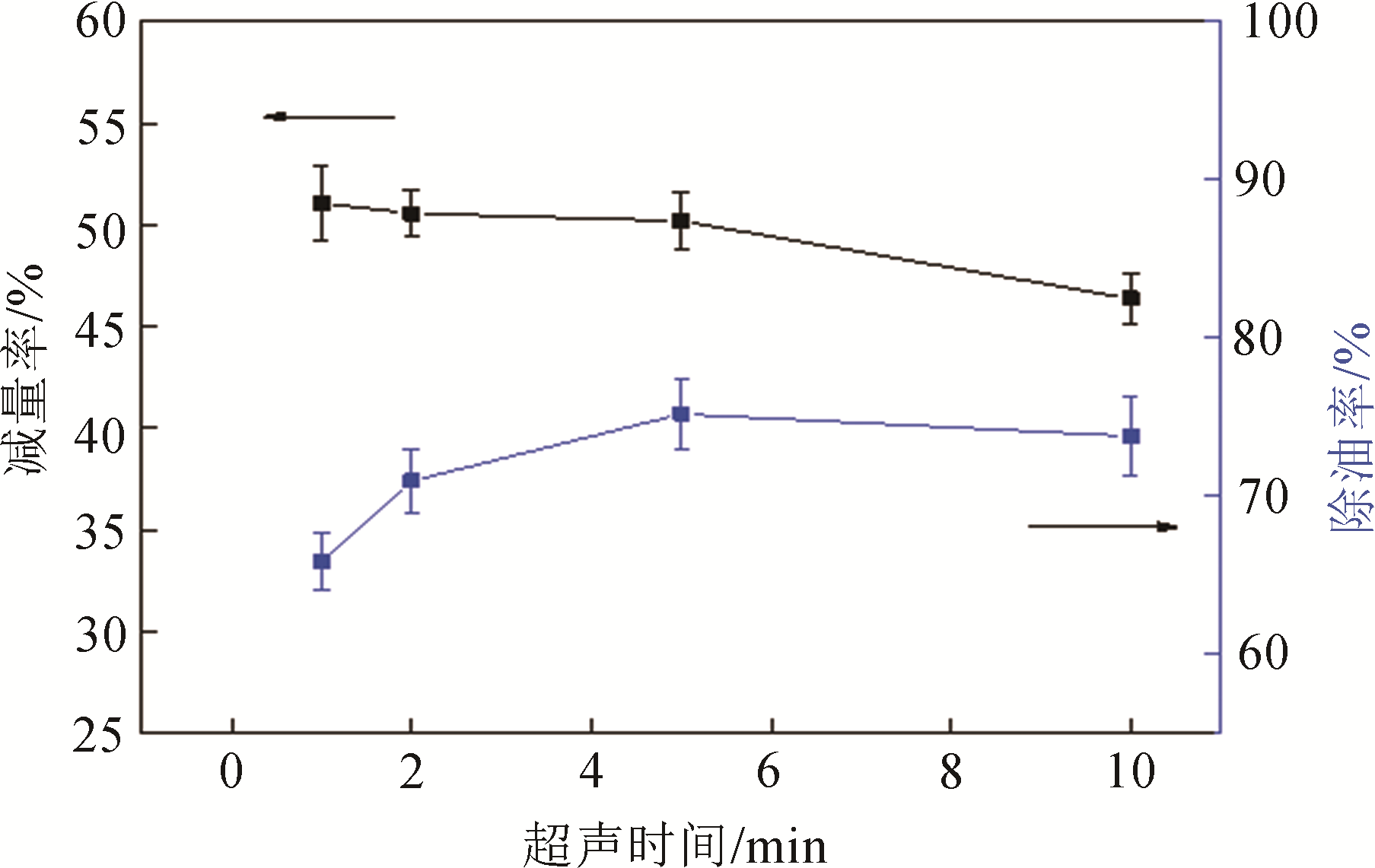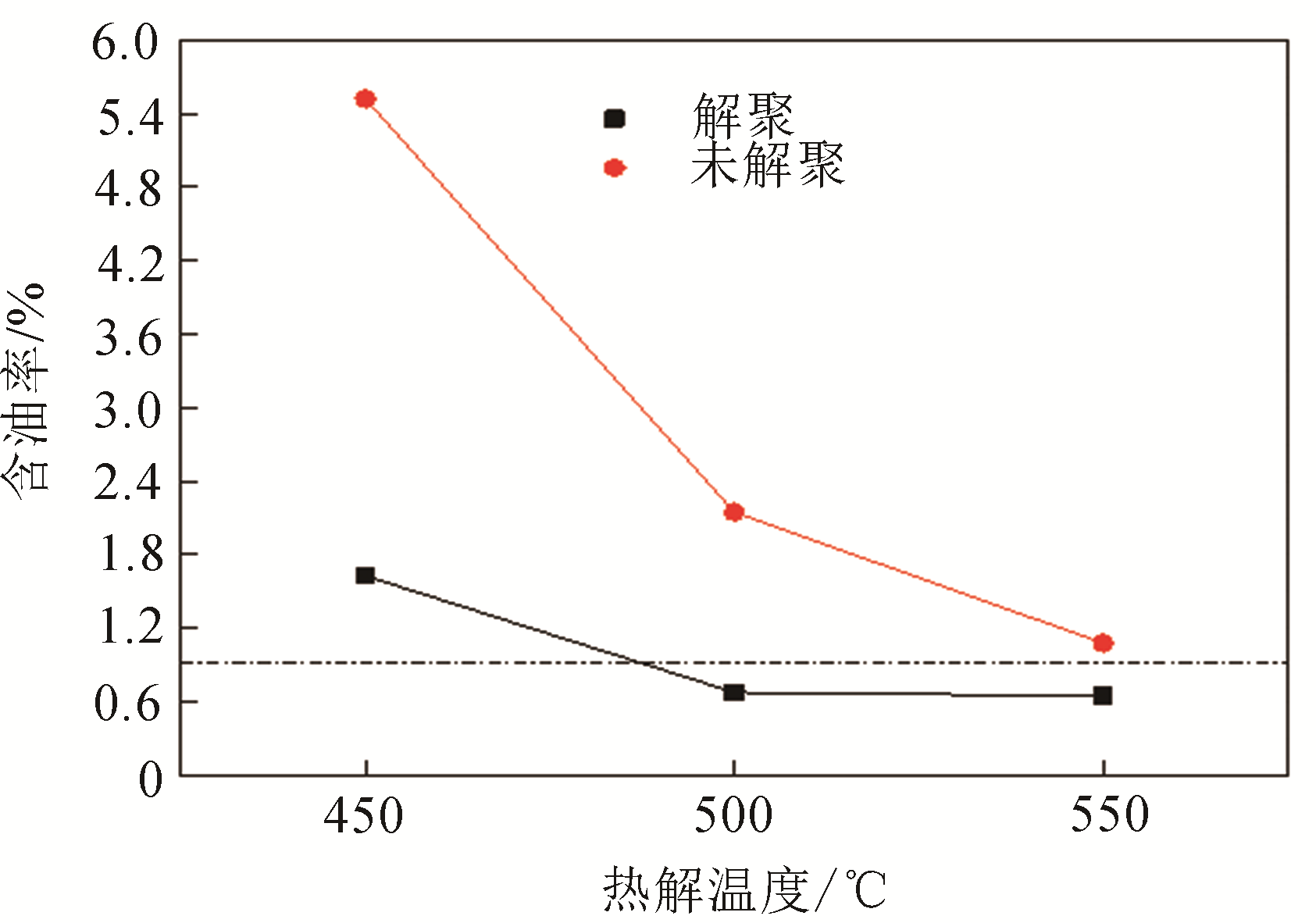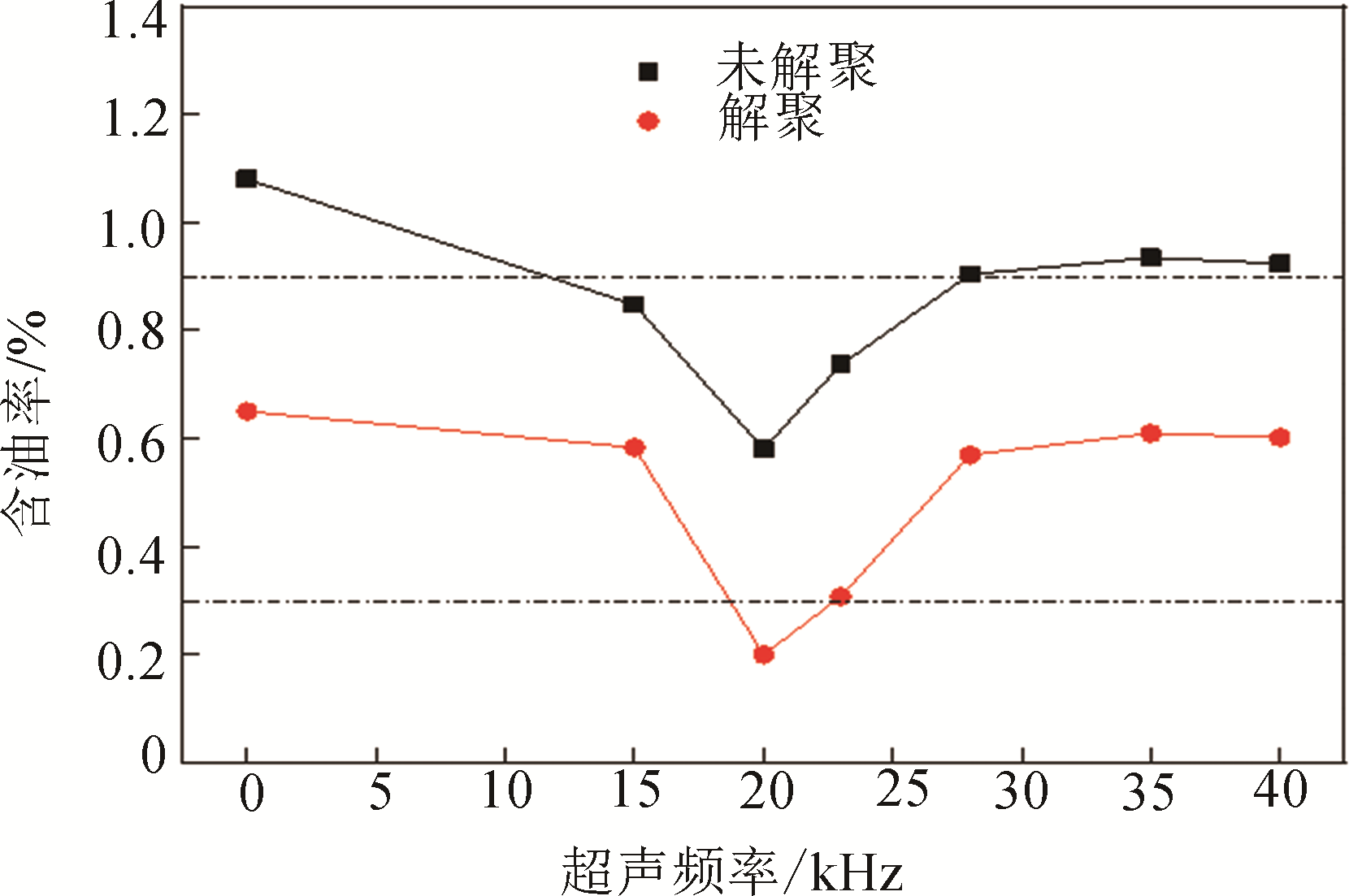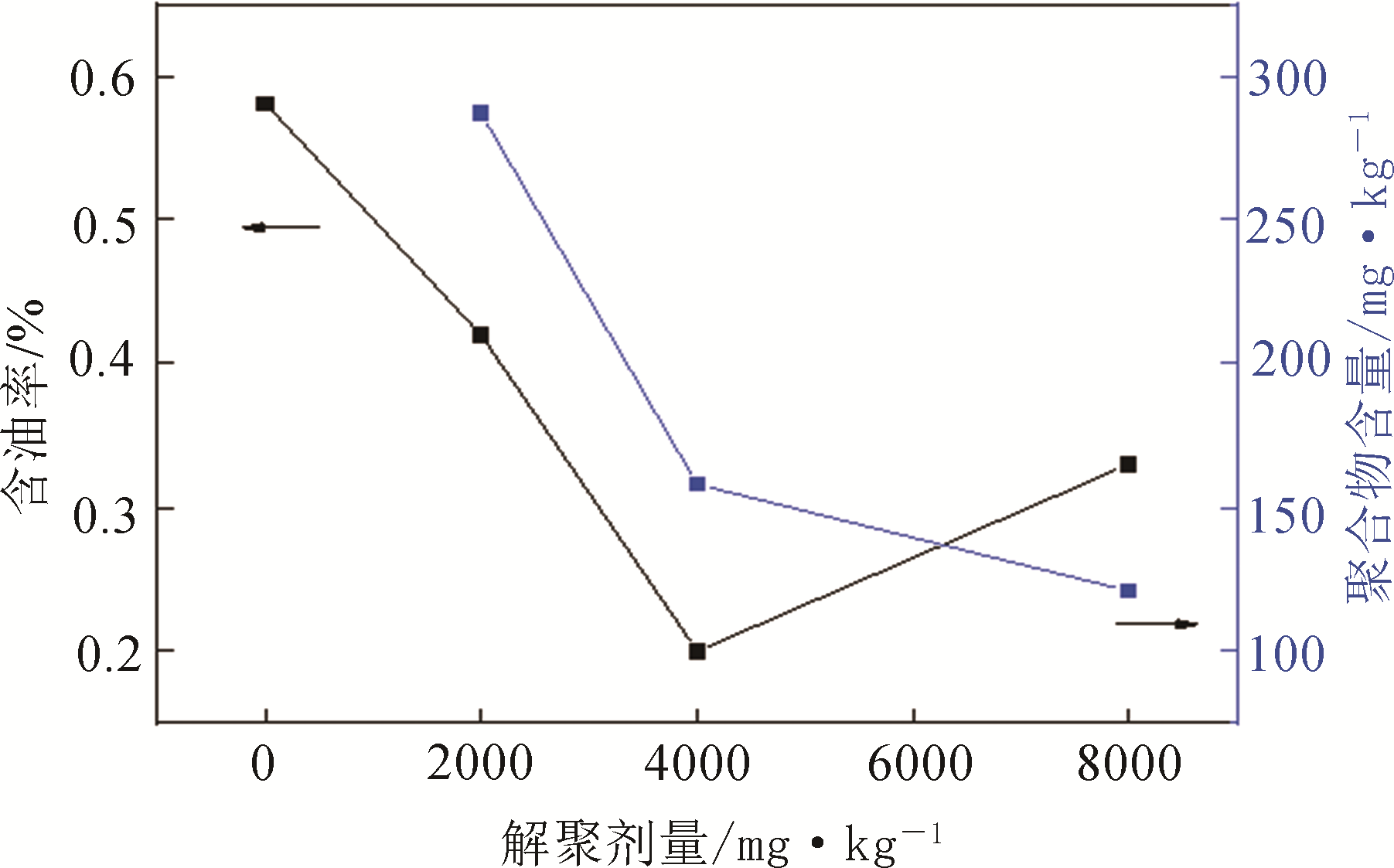Chemical Industry and Engineering Progress ›› 2020, Vol. 39 ›› Issue (S1): 292-299.DOI: 10.16085/j.issn.1000-6613.2020-0280
• Resources and environmental engineering • Previous Articles Next Articles
Collaborative treatment of polymer-containing oil sludgeby ultrasonic and depolymerizing agent
Dayong TENG( ), Jian FANG, Xin ZHANG, Junying XU, Houkai TENG, Xiaoxia JIN, Lishan ZHOU
), Jian FANG, Xin ZHANG, Junying XU, Houkai TENG, Xiaoxia JIN, Lishan ZHOU
- Tianjin Chemical Research & Design Institute, China National Offshore Oil Corporation, Tianjin 300131, China
-
Received:2020-02-28Online:2020-06-29Published:2020-05-20 -
Contact:Dayong TENG
超声波与解聚剂协同处理含聚油泥
滕大勇( ), 方健, 张昕, 徐俊英, 滕厚开, 靳晓霞, 周立山
), 方健, 张昕, 徐俊英, 滕厚开, 靳晓霞, 周立山
- 中海油天津化工研究设计院有限公司,天津 300131
-
通讯作者:滕大勇 -
作者简介:滕大勇(1980—),男,博士,高级工程师,从事油田化学品及油田固废处理的研究。E-mail:noandhave@aliyun.com 。 -
基金资助:中国海洋石油集团有限公司科技项目(EJ719TS09)
CLC Number:
Cite this article
Dayong TENG, Jian FANG, Xin ZHANG, Junying XU, Houkai TENG, Xiaoxia JIN, Lishan ZHOU. Collaborative treatment of polymer-containing oil sludgeby ultrasonic and depolymerizing agent[J]. Chemical Industry and Engineering Progress, 2020, 39(S1): 292-299.
滕大勇, 方健, 张昕, 徐俊英, 滕厚开, 靳晓霞, 周立山. 超声波与解聚剂协同处理含聚油泥[J]. 化工进展, 2020, 39(S1): 292-299.
share this article
Add to citation manager EndNote|Ris|BibTeX
URL: https://hgjz.cip.com.cn/EN/10.16085/j.issn.1000-6613.2020-0280
| 含水率/% | 含油率/% | 含固率/% | 聚合物含量/mg·kg-1 | 工业分析/% | 元素分析/% | 低位热值LHV/MJ·kg-1 | 高位热值HHV/MJ·kg-1 | |||||||
|---|---|---|---|---|---|---|---|---|---|---|---|---|---|---|
MC 水分 | Ash 灰分 | VM 挥发分 | FC 固定碳 | C | H | N | S | O | ||||||
| 31.03 | 54.68 | 14.29 | 4792 | 31.03 | 1.67 | 65.86 | 1.44 | 60.39 | 7.92 | 3.11 | 0.25 | 26.66 | 23.90 | 26.71 |
| 含水率/% | 含油率/% | 含固率/% | 聚合物含量/mg·kg-1 | 工业分析/% | 元素分析/% | 低位热值LHV/MJ·kg-1 | 高位热值HHV/MJ·kg-1 | |||||||
|---|---|---|---|---|---|---|---|---|---|---|---|---|---|---|
MC 水分 | Ash 灰分 | VM 挥发分 | FC 固定碳 | C | H | N | S | O | ||||||
| 31.03 | 54.68 | 14.29 | 4792 | 31.03 | 1.67 | 65.86 | 1.44 | 60.39 | 7.92 | 3.11 | 0.25 | 26.66 | 23.90 | 26.71 |
| 聚合物含量/mg·kg-1 | |||||||||
|---|---|---|---|---|---|---|---|---|---|
| 0kHz, 0min | 15kHz, 5min | 20kHz, 5min | 23kHz, 5min | 28kHz, 5min | 35kHz, 1min | 35kHz, 2min | 35kHz, 5min | 35kHz, 10min | 40kHz, 5min |
| 4792 | 4588 | 4541 | 4535 | 4497 | 4708 | 4627 | 4419 | 4311 | 4286 |
| 聚合物含量/mg·kg-1 | |||||||||
|---|---|---|---|---|---|---|---|---|---|
| 0kHz, 0min | 15kHz, 5min | 20kHz, 5min | 23kHz, 5min | 28kHz, 5min | 35kHz, 1min | 35kHz, 2min | 35kHz, 5min | 35kHz, 10min | 40kHz, 5min |
| 4792 | 4588 | 4541 | 4535 | 4497 | 4708 | 4627 | 4419 | 4311 | 4286 |
| 解聚剂量/mg·kg-1 | 聚合物含量/mg·kg-1 |
|---|---|
| 0 | 4792 |
| 2000 | 403 |
| 4000 | 217 |
| 80000 | 162 |
| 解聚剂量/mg·kg-1 | 聚合物含量/mg·kg-1 |
|---|---|
| 0 | 4792 |
| 2000 | 403 |
| 4000 | 217 |
| 80000 | 162 |
| 解聚剂量/mg·kg-1 | 热解固渣含油/% |
|---|---|
| 0 | 5.53 |
| 2000 | 3.08 |
| 4000 | 1.62 |
| 8000 | 3.26 |
| 解聚剂量/mg·kg-1 | 热解固渣含油/% |
|---|---|
| 0 | 5.53 |
| 2000 | 3.08 |
| 4000 | 1.62 |
| 8000 | 3.26 |
| 1 | 杨付林. 聚合物驱油机理及高质量浓度聚合物驱油方法的研究[D]. 大庆: 大庆石油学院, 2004. |
| YANG Fulin. Mechanism of polymer flooding and a new enhanced oil recovery of high concentration polymer flooding[D]. Daqing: Northeast Petroleum University, 2004. | |
| 2 | 周守为, 韩明, 向问陶, 等. 渤海油田聚合物驱提高采收率技术研究及应用[J]. 中国海上油气, 2006, 18(6): 386-389. |
| ZHOU Shouwei, HAN Ming, XIANG Wentao, et al. Application of EOR technology by means of polymer flooding in Bohai oilfields[J]. China offshore Oil and Gas, 2006, 18(6): 386-389. | |
| 3 | 山金成, 刘义刚, 卢祥国. 聚合物驱在渤海旅大10-1油田的应用[J]. 海洋石油, 2009, 29(1): 47-53. |
| SHAN Jincheng, LIU Yigang, LU Xiangguo. The application of polymer flooding in LD10-1 offshore oilfield[J]. Offshore Oil, 2009, 29(1): 47-53. | |
| 4 | 郑旭, 赵春明, 王世民, 等. 渤海锦州9-3油田注聚动态分析及优化调整技术研究[J]. 石油地质与工程, 2010, 24(2): 133-136. |
| ZHENG Xu, ZHAO Chunming, WANG Shimin, et al. Dynamic analysis of polymer injection in Jinzhou 9-3 oilfield in bohai and research on optimization and adjustment technology[J]. Petroleum Geology and Engineering, 2010, 24(2): 133-136. | |
| 5 | 王秀军, 张健, 翟磊, 等. 聚驱油田采出液处理生成油泥的组成及形成机理[J]. 化工环保, 2016, 36(4): 364-369. |
| WANG Xiujun, ZHANG Jian, ZHAI Lei, et al. Components and formation mechanism of oily sludge generated in treatment of polymer-flooding produced water[J]. Environmental Protection of Chemical Industry, 2016, 36(4): 364-369. | |
| 6 | 徐文江, 戴照辉, 温哲华, 等. 海上典型注聚油田产出液处理问题及措施研究[J]. 工业水处理, 2016, 36(8): 93-96. |
| XU Wenjiang, DAI Zhaohui, WEN Zhehua, et al. Problems in and measurements of the treatment of output liquid in typical offshore polymer injection oil fields[J]. Industrial Water Treatment, 2016, 36(8): 93-96. | |
| 7 | 王琦, 李美蓉, 祝威, 等. 不同类型清洗剂对含聚油泥清洗效果及界面性质的影响[J]. 环境工程学报, 2012, 6(5): 1739-1743. |
| WANG Qi, LI Meirong ZHU Wei, et al. Polymer sludge cleaning effects of different types of detergents and their influence on interfacial properties[J]. Chinese Journal of Environmental Engineering, 2012, 6(5): 1739-1743. | |
| 8 | 路平, 曲兆光, 刘春雨, 等. 某终端沉降罐改造及污泥干化技术应用[J]. 中国石油和化工, 2016(S1): 314. |
| LU Ping, QU Zhaoguang, LIU Chunyu, et al. Modification of terminal setting tank and application of sludge drying technology[J]. China Petroleum and Chemical Industry, 2016(S1): 314. | |
| 9 | 张雷. 超声强化工艺处理三元驱采油污水和含油污泥效能的研究[D]. 哈尔滨: 哈尔滨工业大学, 2014. |
| ZHANG Lei. Treating efficiency of ASP flooding produced waster-water and oily sludge by ultrasound enhancement process[D]. Harbin: Harbin Institute of Technology, 2014. | |
| 10 | 苏延辉, 王秀平, 刘敏, 等. 海上S油田含聚油泥超声波洗脱除油实验研究[J]. 应用化工, 2014, 43(10): 1928-1929. |
| SU Yanhui, WANG Xiuping, LIU Min, et al. Experimental research on crude oil removal from oily sludge containing polymer of offshore S oilfield by ultrasonic[J]. Applied Chemical Industry, 2014, 43(10): 1928-1929. | |
| 11 | 雍兴跃, 张建, 祝威, 等. 半干化含聚油泥的微波热处理过程研究[J]. 石油与天然气化工, 2010, 39(4): 354-359. |
| YONG Xingyue, ZHANG Jian, ZHU Wei, et al. Microwave pyrolysis process of half-dried oil sludge containing PAC[J]. Chemical Engineering of Oil &Gas, 2010, 39(4): 354-359. | |
| 12 | 张健, 雍兴跃, 祝威, 等. 深度干化含聚油泥的微波热解过程研究[J]. 环境工程, 2010, 28(S1): 241-245. |
| ZHANG Jian, YONG Xingyue, ZHU Wei, et al. Microwave pyrolysis process of deep-dried oil sludge containing PAC[J]. Environmental Engineering, 2010, 28(S1): 241-245. | |
| 13 | 庞小肖, 张建, 屈一新, 等. 含聚油泥微波热解强化技术研究[J]. 北京化工大学学报(自然科学版), 2011, 38(5): 105-110. |
| PANG Xiaoxiao, ZHANG Jian, QU Yixin, et al. Acceleration of the microwave pyrolysis of oily sludge[J]. Journal of Beijing University of Chemical Technology (Natural Science), 2011, 38(5): 105-110. | |
| 14 | 胡菲菲, 李庆, 靖波, 等. 海上含聚油泥处理后泥水的回注[J]. 化工环保, 2015, 35(4): 381-385. |
| HU Feifei, LI Qing, JING Bo, et al. Reinjection of sediment and sewage from treatment of polymer-containing oily sludge in offshore oilfield[J]. Environmental Protection of Chemical Industry, 2015, 35(4): 381-385. | |
| 15 | 尹先清, 刘晓瑜, 靖波, 等. 海上平台含聚油泥处理撬装装置设计及工艺研究[J]. 长江大学学报(自然科学版), 2015, 12(10): 24-26. |
| YIN Xianqing, LIU Xiaoyu, JING Bo, et al. Study on design and technology of polymer-containing oily sludge in offshore platform[J]. Journal of Yangtze University (Natural Science Edition), 2015, 12(10): 24-26. | |
| 16 | 余胜军, 吕永恒. 河南油田含油、含聚合物污泥无害化处理的应用研究[J]. 长江大学学报(自然科学版), 2015, 12(2): 75-78. |
| YU Shengjun, LU Yongheng. Application of harmless treatment of oil- and polymer-containing sludge in Henan oilfield[J]. Journal of Yangtze University (Natural Science Edition), 2015, 12(2): 75-78. | |
| 17 | 康东会, 王伟, 吴嫡, 等. 加工绥36-1原油时换热器堵塞原因分析及在线清洗研究[J]. 石油炼制与化工, 2016, 47(8): 40-43. |
| KANG Donghui, WANG Wei, WU Di, et al. Cause analysis of blockage of heat exchanger for processing Suizhong 36-1 crude and online cleaning study[J]. Petroleum Processing and Petrochemicals, 2016, 47(8): 40-43. | |
| 18 | 刘晓瑜, 王文斌, 尹先清, 等. 含聚油泥处理技术及研究进展[J]. 中外能源, 2013, 18(9): 86-91. |
| LIU Xiaoyu, WANG Wenbin, YIN Xianqing, et al. Polymer-containing oily sludge treatment technology and research progress[J]. Sino-Global Energy, 2013, 18(9): 86-91. | |
| 19 | 郑秋生, 邵天泽, 霍志坚, 等. 含聚油泥处理技术研究[J]. 油气田环境保护, 2014, 24(2): 9-11. |
| ZHENG Qiusheng, SHAO Tianze, HUO Zhijian, et al. Research on the technology of treating polymer-contained oily sludge[J]. Enviromental Protection of Oil & Gas Fields, 2014, 24(2): 9-11. | |
| 20 | 方健, 滕大勇, 齐远, 等. 油田含聚油泥性质及处理技术研究进展[J]. 当代化工, 2019, 48(8): 1787-1790. |
| FANG Jian, TENG Dayong, QI Yuan, et al. Research progress of polymer-containing oily sludge treatment technology in oilfields[J]. Contemporary Chemical Industry, 2019, 48(8): 1787-1790. | |
| 21 | 刘德新, 赵修太, 邱广敏. 驱油用聚丙烯酰胺降解研究进展[J]. 高分子材料科学与工程, 2008, 24(9): 27-31. |
| LIU D X, ZHAO X T, QIU G M. Review on the degradation of polyacrylamide used for flooding[J]. Polymer Materials Science and Engineering, 2008, 24(9): 27-31. | |
| 22 | 王增宝, 白英睿, 赵修太, 等. 聚丙烯酰胺化学降解技术研究进展[J]. 油气田环境保护, 2012, 22(4): 69-71. |
| WANG Zengbao, BAI Yingrui, ZHAO Xiutai, et al. Review on the chemical degradation of polyacrylamide[J]. Environmental Protection of Oil & Gas Fields, 2012, 22(4): 69-71. | |
| 23 | 王泉, 祝宏平, 李洁冰, 等. 超声波降解油田含聚污水研究进展[J]. 声学技术, 2018, 37(2): 141-145. |
| WANG Quan, ZHU Hongping, LI Jiebing, et al. Research progress in ultrasonic degradation technique of polymer-bearing oilfield wastewater[J]. Technical Acoustics, 2018, 37(2): 141-145. | |
| 24 | 冯茹森, 郭拥军, 罗平亚, 等. 疏水缔合性聚丙烯酰胺溶液流变性研究进展[J]. 中国海上油气, 2009, 21(5): 324-328. |
| FENG Rusen, GUO Yongjun, LUO Pingya, et al. Advances in researching rheological property of hydrophobically associated polyacrylamide[J]. China Offshore Oil and Gas, 2009, 21(5): 324-328. | |
| 25 | 胡馨. 不同黏土矿物质对超声处理含油污泥影响的机理研究[D]. 徐州: 中国矿业大学, 2014. |
| HU Xin. Study on the mechanism of effects of different clay minerals on the ultrasonic treatment of oil sludge[D]. Xuzhou: China University of Mining and Technology, 2014. | |
| 26 | 温军杰, 贾永刚, 陈欢林, 等. 超声清洗石油污染海滨土的效果与影响因素[J]. 化工学报, 2011, 62(5): 1448-1454. |
| WEN Junjie, JIA Yonggang, CHEN Huanlin, et al. Impact factor of sonochemical cleaning technique decontaminating petroleum hydrocarbon- contaminated beach fine soil[J]. CIESC Journal, 2011, 62(5): 1448-1454. | |
| 27 | 赵晓非, 葛丹, 张晓阳. 超声波-破乳联用技术处理大庆落地油泥[J]. 化工进展, 2017, 36(S1): 489-494. |
| ZHAO Xiaofei, GE Dan, ZHANG Xiaoyang. Treatment of oily sludge in Daqing by ultrasonic-demulsification hyphenated technique[J]. Chemical Industry and Engineering Progress, 2017, 36(S1): 489-494. | |
| 28 | 吴嫡, 潘岩, 葛玉龙, 等. 超声波降解含聚原油中AP-P4的研究[J]. 齐鲁石油化工, 2017, 45(3): 187-190. |
| WU Di, PAN Yan, GE Yulong, et al. Research on the degradation of AP-P4 in polymer containing crude oil by ultrasonic[J]. Qilu Petrochemical Technology, 2017, 45(3): 187-190. | |
| 29 | 黑龙江省环境保护厅, 黑龙江省质量技术监督局. 油田含油污泥综合利用污染控制标准: DB23/T 1413—2010[S]. 2010.Heilongjiang Department of Environmental Protection, Heilongjiang Bureau of Quality and Technical Supervision. Pollution control standard for comprehensive utilization of oilfield oily sludge: DB23/T 1413—2010[S]. 2010. |
| 30 | 陕西省质量技术监督局. 含油污泥处置利用控制限值: DB61/T 1025—2016[S]. 2016.Shaanxi Bureau of Quality and Technical Supervision. Limits for the disposal and utilization of oily sludge: DB61/T 1025—2016[S]. 2016. |
| 31 | 国家能源局. 陆上石油天然气开采含油污泥资源化综合利用及污染控制技术要求: SY/T 7301—2016[S]. 2016.National Energy Administration. Pollution control requirements of oily sludge recycling and utilization for onshore oil & natural gas exploitation: SY/T 7301—2016[S]. 2016. |
| 32 | 新疆维吾尔自治区质量技术监督局. 油气田含油污泥综合利用污染控制要求: DB65/T 3998—2017[S]. 2017.Bureau of Quality and Technical Supervision of Xinjiang Uygur Autonomous Region. Pollution control requirements for comprehensive utilization of oil and gas field oily sludge: DB65/T 3998—2017[S]. 2017. |
| 33 | 刘颖. 聚丙烯酰胺的化学降解[J]. 油气田地面工程, 2009, 28(5): 35-36. |
| LIU Ying. Chemical degradation of polyacrylamide[J]. Oil-Gas Field Surface Engineering, 2009, 28(5): 35-36. |
| [1] | SHAO Boshi, TAN Hongbo. Simulation on the enhancement of cryogenic removal of volatile organic compounds by sawtooth plate [J]. Chemical Industry and Engineering Progress, 2023, 42(S1): 84-93. |
| [2] | XIANG Shuo, LU Peng, SHI Weinian, YANG Xin, HE Yan, ZHU Liye, KONG Xiangwei. Controllable and large-scale preparation of two-dimensional WS2 nanosheet and its tribological properties as lubricant additives in lithium grease [J]. Chemical Industry and Engineering Progress, 2023, 42(9): 4783-4790. |
| [3] | QIAN Sitian, PENG Wenjun, ZHANG Xianming. Comparative analysis of forming cyclic oligomers via PET melt polycondensation and cyclodepolymerization [J]. Chemical Industry and Engineering Progress, 2023, 42(9): 4808-4816. |
| [4] | LI Zhiyuan, HUANG Yaji, ZHAO Jiaqi, YU Mengzhu, ZHU Zhicheng, CHENG Haoqiang, SHI Hao, WANG Sheng. Characterization of heavy metals during co-pyrolysis of sludge with PVC [J]. Chemical Industry and Engineering Progress, 2023, 42(9): 4947-4956. |
| [5] | LI Haidong, YANG Yuankun, GUO Shushu, WANG Benjin, YUE Tingting, FU Kaibin, WANG Zhe, HE Shouqin, YAO Jun, CHEN Shu. Effect of carbonization and calcination temperature on As(Ⅲ) removal performance of plant-based Fe-C microelectrolytic materials [J]. Chemical Industry and Engineering Progress, 2023, 42(7): 3652-3663. |
| [6] | YAO Liming, WANG Yazhuo, FAN Honggang, GU Qing, YUAN Haoran, CHEN Yong. Treatment status of kitchen waste and its research progress of pyrolysis technology [J]. Chemical Industry and Engineering Progress, 2023, 42(7): 3791-3801. |
| [7] | LU Yang, ZHOU Jinsong, ZHOU Qixin, WANG Tang, LIU Zhuang, LI Bohao, ZHOU Lingtao. Leaching mechanism of Hg-absorption products on CeO2/TiO2 sorbentsin syngas [J]. Chemical Industry and Engineering Progress, 2023, 42(7): 3875-3883. |
| [8] | ZHANG Shan, ZHONG Zhaoping, YANG Yuxuan, DU Haoran, LI Qian. Enrichment of heavy metals in pyrolysis of municipal solid waste by phosphate modified kaolin [J]. Chemical Industry and Engineering Progress, 2023, 42(7): 3893-3903. |
| [9] | XIU Haoran, WANG Yungang, BAI Yanyuan, ZOU Li, LIU Yang. Combustion characteristics and ash melting behavior of Zhundong coal/municipal sludge blended combustion [J]. Chemical Industry and Engineering Progress, 2023, 42(6): 3242-3252. |
| [10] | LI Ruolin, HE Shaolin, YUAN Hongying, LIU Boyue, JI Dongli, SONG Yang, LIU Bo, YU Jiqing, XU Yingjun. Effect of in-situ pyrolysis on physical properties of oil shale and groundwater quality [J]. Chemical Industry and Engineering Progress, 2023, 42(6): 3309-3318. |
| [11] | LI Dongxian, WANG Jia, JIANG Jianchun. Producing biofuels from soapstock via pyrolysis and subsequent catalytic vapor-phase hydrotreating process [J]. Chemical Industry and Engineering Progress, 2023, 42(6): 2874-2883. |
| [12] | WANG Zhiwei, GUO Shuaihua, WU Mengge, CHEN Yan, ZHAO Junting, LI Hui, LEI Tingzhou. Recent advances on catalytic co-pyrolysis of biomass and plastic [J]. Chemical Industry and Engineering Progress, 2023, 42(5): 2655-2665. |
| [13] | LIANG Yijing, MA Yan, LU Zhanfeng, QIN Fusheng, WAN Junjie, WANG Zhiyuan. Experimental investigation on the anti-coking performance of La1-x Sr x MnO3 perovskite coating [J]. Chemical Industry and Engineering Progress, 2023, 42(4): 1769-1778. |
| [14] | LIU Jing, LIN Lin, ZHANG Jian, ZHAO Feng. Research progress in pore size regulation and electrochemical performance of biomass-based carbon materials [J]. Chemical Industry and Engineering Progress, 2023, 42(4): 1907-1916. |
| [15] | YANG Ziqiang, LI Fenghai, GUO Weijie, MA Mingjie, ZHAO Wei. Review on phosphorus migration and transformation during municipal sewage sludge heat treatment [J]. Chemical Industry and Engineering Progress, 2023, 42(4): 2081-2090. |
| Viewed | ||||||
|
Full text |
|
|||||
|
Abstract |
|
|||||





